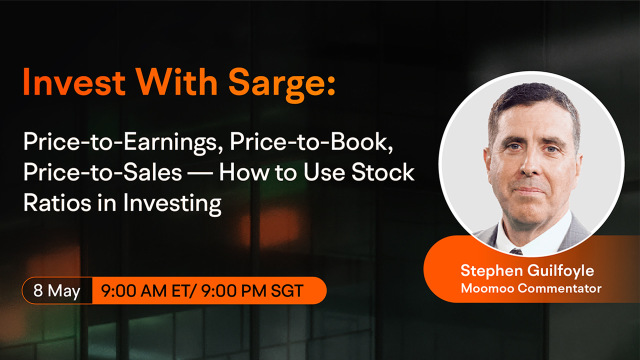Invest With Sarge:Price-to-Earnings, Price-to-Book, Price-to-Sales - How to Use Stock Ratios in Investing

Invest with sarge: How to use stock ratios in investing
May 8 08:00
Dear mooers, Sarge is back again to our live streaming event. This time we’re going to talk about ratios – price-to-earnings, price-to-book and others – along with a few other fundamental measures that Wall Street uses to assess stocks.
Many investors are familiar with the P/E or “price-to-earnings” ratio, but did you know that there are actually two versions of it – the forward P/E and the trailing one? Or that there’s a variant called the “price-to-earnings-to-growth” or P/E/G ratio?
Sarge will give us a rundown of these and some other fundamental indicators that investors might want to use to measure a given stock.
You are welcome to ask any questions related to this topic. Stephen will address your inquiries during the live broadcast. Submit a complete question under this post and you’ll receive 100 Moo points, plus another 1,000 if we use your question on air.
[Stephen’s Full Bio]
Stephen "Sarge" Guilfoyle is the founder and President of Sarge986 LLC, a family run trading operation. An NYSE floor trader for over 30 years, Guilfoyle has served as the Chief Market Economist for Stuart Frankel & Co., the U.S. Economist for Meridian Equity Partners, and as a Vice President in Block Trading and Investment Banking with Credit Suisse over the years. Guilfoyle earned his nickname “Sarge” while serving as an actual sergeant in reserve components of the U.S. Marine Corps, and U.S. Army while simultaneously working on Wall Street. He self-identifies as a day trader, long-term investor, and anything in between. He believes in removing the emotion out of the decision-making process and trusting the data. Follow Stephen “Sarge” Guilfoyle on moomoo community for a mix of fundamentals, technical analysis, economic commentary and trading ideas.
Stephen "Sarge" Guilfoyle is the founder and President of Sarge986 LLC, a family run trading operation. An NYSE floor trader for over 30 years, Guilfoyle has served as the Chief Market Economist for Stuart Frankel & Co., the U.S. Economist for Meridian Equity Partners, and as a Vice President in Block Trading and Investment Banking with Credit Suisse over the years. Guilfoyle earned his nickname “Sarge” while serving as an actual sergeant in reserve components of the U.S. Marine Corps, and U.S. Army while simultaneously working on Wall Street. He self-identifies as a day trader, long-term investor, and anything in between. He believes in removing the emotion out of the decision-making process and trusting the data. Follow Stephen “Sarge” Guilfoyle on moomoo community for a mix of fundamentals, technical analysis, economic commentary and trading ideas.
*Disclaimer:
Options trading is risky and not appropriate for everyone. Read the Options Disclosure Document (j.us.moomoo.com/00xBBz) before trading. Options are complex and you may quickly lose the entire investment. Supporting docs for any claims will be furnished upon request. This presentation is for informational and educational use only and is not a recommendation or endorsement of any particular investment or financial strategy
Options trading is risky and not appropriate for everyone. Read the Options Disclosure Document (j.us.moomoo.com/00xBBz) before trading. Options are complex and you may quickly lose the entire investment. Supporting docs for any claims will be furnished upon request. This presentation is for informational and educational use only and is not a recommendation or endorsement of any particular investment or financial strategy
Disclaimer: Moomoo Technologies Inc. is providing this content for information and educational use only.
Read more
Comment
Sign in to post a comment

mr_cashcow : Hello again, my question is how do we figure out and determine what is a good price to earnings ratio?
102362254 : Question 1 - How does Price-to-Book (P/B) ratio differ from Price-to-Earnings (P/E) ratio, and what insights does it offer about a company's financial health?
Question 2 - What are the limitations and drawbacks of relying solely on stock ratios like P/E, P/B, and P/S in making investment decisions, and how can investors mitigate these limitations?
erin39 : Hi. When we do use P/E, P/B, P/S in assessing stocks? Can we use just 1 or all 3? Thank you.
010Leo : how does one justify the p/e for a specific sector? or we say this stock too expensive just becos it's p/e lower than its peer. more recently I've heard more comparing based on p/b instead. is usage sector based? or can combine both?
doctorpot1 : Could you elaborate on how the P/E ratio and its variants, such as forward P/E and P/E/G, can provide different perspectives on a stock's valuation, and how should retail investors use these metrics effectively in their investment decisions?
doctorpot1 : Could you explain the significance of using both forward and trailing P/E ratios when evaluating a stock? And how does the P/E/G ratio provide additional insights into a company's growth potential compared to traditional P/E ratios?
cola1010 : What are the key factors investors should consider when analyzing the P/E/G ratio? How can investors use these fundamental measures to identify potential opportunities or risks in the stock market?
Wonder : how to know which valuation methods are more suited for different industries? Which combinations of measurements work best? Like for tech companies, DCF is preferred?
ZnWC : Thanks for sharing Here are my questions:
Here are my questions:
1. I learned that we should compare P/E/G ratio with companies of the same industry. Why is media comparing the ratio among the magnificent seven stocks?
2. For a big market cap company, is it fair to compare the PE ratio with a small one (startup company)? Why?
3. For companies like Tesla and Meta Platform which have very high share price and re-invested a major portion of its earnings to growth like research, do you think their high PE ratio is a risk or opportunity?
74024341 : is there a quick way to spot when P/E, P/B, P/ S or PEG values have been unrealistic or manipulated?
View more comments...